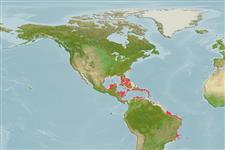>
Gobiiformes (Gobies) >
Gobiidae (Gobies) > Gobiinae
Etymology: Coryphopterus: Greek, koryphe = summit + Greek, pteron = fin, wing (Ref. 45335).
More on authors: Böhlke & Robins.
Environment: milieu / climate zone / depth range / distribution range
पारिस्थितिकी
समुद्री प्रवाल-भित्ति संयुक्त; गहराई सीमा 10 - 20 m. Tropical
Western Atlantic: southern Florida in USA and the Bahamas (Ref. 7251) to Brazil (Ref. 51894).
आकार / वज़न / Age
Maturity: Lm ? range ? - ? cm
Max length : 5.0 cm TL पुल्लिंग / अलिंग; (Ref. 7251)
Inhabits patch reefs (Ref. 5521).
Life cycle and mating behavior
Maturities | पुनरुत्पत्ति | Spawnings | Egg(s) | Fecundities | लार्वा
Benthic spawner.
Robins, C.R. and G.C. Ray, 1986. A field guide to Atlantic coast fishes of North America. Houghton Mifflin Company, Boston, U.S.A. 354 p. (Ref. 7251)
IUCN Red List Status (Ref. 130435)
Threat to humans
Harmless
Human uses
साधन
Special reports
Download XML
इंटरनेट स्रोत
Estimates based on models
Preferred temperature (Ref.
123201): 24.9 - 28.2, mean 27.3 °C (based on 784 cells).
Phylogenetic diversity index (Ref.
82804): PD
50 = 0.5001 [Uniqueness, from 0.5 = low to 2.0 = high].
Bayesian length-weight: a=0.00708 (0.00333 - 0.01504), b=3.09 (2.92 - 3.26), in cm total length, based on LWR estimates for this (Sub)family-body shape (Ref.
93245).
Trophic level (Ref.
69278): 2.7 ±0.4 se; based on size and trophs of closest relatives
लौटाव (Ref.
120179): ऊंचा, न्यूनतम जनसंख्या दुगनी समय अवलागत 15 महीने। (Preliminary K or Fecundity.).
Fishing Vulnerability (Ref.
59153): Low vulnerability (10 of 100).
Nutrients (Ref.
124155): Calcium = 250 [111, 582] mg/100g; Iron = 1.13 [0.53, 2.29] mg/100g; Protein = 17.6 [15.6, 19.4] %; Omega3 = 0.0918 [, ] g/100g; Selenium = 26.6 [10.8, 65.4] μg/100g; VitaminA = 115 [26, 486] μg/100g; Zinc = 3.2 [2.0, 5.0] mg/100g (wet weight);
